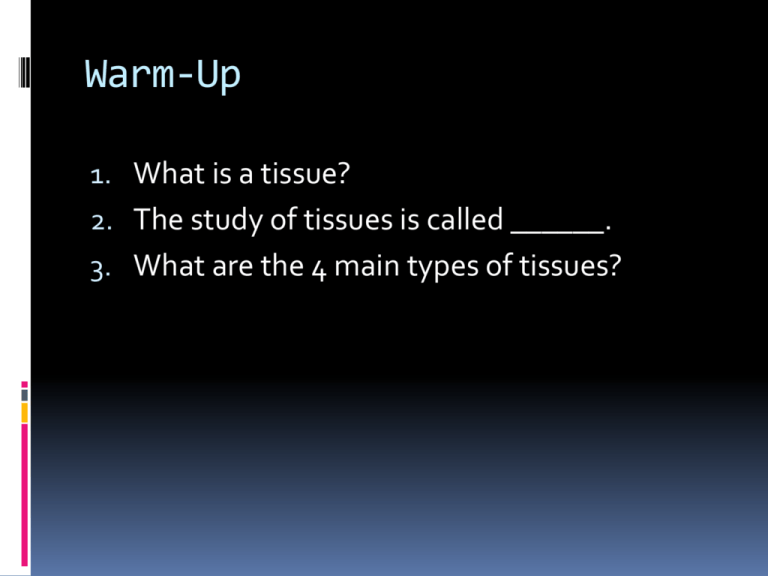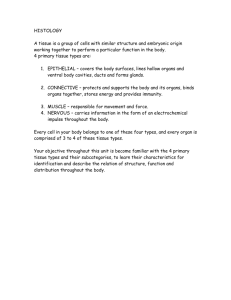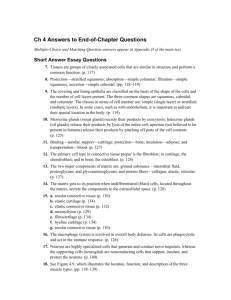Tissue: The Living Fabric
advertisement

Warm-Up 1. What is a tissue? 2. The study of tissues is called ______. 3. What are the 4 main types of tissues? Chapter 5 TISSUE: THE LIVING FABRIC Tissue: group of cells that are similar in structure and function Histology: study of tissues Types of Tissues: 1. Epithelium (covering) 2. Connective (support) 3. Muscle (movement) 4. Nervous (control) Epithelial Tissue “epithe” = laid on, covering Structure: 1. Covering and lining epithelium 2. Glandular epithelium Function: Protection Absorption Filtration Secretion Special Properties 1. Polarity Apical surface = exposed free surface or edge (some with microvilli, cilia) Basal surface = lower, attached surface 2. Specialized contacts Fits close together to form continuous sheets Special Properties 3. Supported by connective tissue Rests on basement membrane 4. No blood supply (avascular) Rely on diffusion and underlying connective tissue for food/O2 5. Regeneration – Replace lost cells Classification Two names = (# cell layers) + (shape of cells) Cell Layers: simple (single) or stratified (many) Shapes: squamous, cuboidal, or columnar Simple Epithelium Absorption, secretion, filtration Very thin Simple Epithelium Simple Epithelium Simple squamous Filtration, rapid diffusion Capillary walls, air sacs in lungs, kidney filtration Serous membranes: slick layer lining ventral body cavity and its organs Simple Epithelium Simple cuboidal Secretion & absorption Lines ducts of glands (salivary), kidney tubules, ovary surface Simple Epithelium Simple columnar Absorption and secretion Lines digestive tract Microvilli, cilia Mucous membranes: lubricating mucus Simple Epithelium Pseudostratified columnar Rests on basement membrane – false impression (pseudo) of being multi-layered Secretes or absorbs Respiratory tract – cilia propels mucus from lungs Stratified Epithelium 2+ layers, more durable Main function = protect Stratified Epithelium Stratified squamous Withstand abuse, friction Esophagus, mouth, outer portion of skin Stratified Epithelium Stratified cuboidal Usually 2 layers Mainly in ducts of large glands (sweat, mammary, salivary) Sweat Gland Esophageal Gland Stratified Epithelium Stratified columnar Thick, waterproof layer Pharynx, male urethra, lining ducts Transitional Epithelium Able to change shape (cuboidal squamous) Lining of hollow urinary organs (bladder, ureter, urethra) Stretches when filled with urine Glandular Epithelium Gland: make and secrete a particular product 2 Types: Endocrine gland: produce hormones secreted into tissue fluid or bloodstream; ductless Exocrine gland: secrete products into ducts onto body surfaces or body cavities Eg. mucous, sweat, oil, saliva, bile Unicellular exocrine gland: Composed of one cell Goblet cell Multicellular exocrine gland: • Composed of many cells • Sweat glands, salivary glands, etc. • Simple and compound Exocrine Glands Unicellular Multicellular Mucus cells or goblet cells Duct structure Structural Types of Exocrine Glands Copyright © The McGraw-Hill Companies, Inc. Permission required for reproduction or display. Tissue surface Duct Secretory portion Simple tubular Simple branched tubular Compound tubular Simple coiled tubular Compound alveolar Simple branched alveolar Types of Glandular Secretions • Merocrine Glands • Fluid product • Salivary glands • Pancreas • Sweat glands (also called Eccrine) Intact cell Secretion • Apocrine Glands • Cellular product • Portions of cells • Mammary glands • Ceruminous glands Pinched off portion of cell (secretion) • Holocrine Glands • Secretory products • Whole cells • Sebaceous glands Disintegrating cell and its contents (secretion) New cell forming by mitosis and cytokinesis (a) Merocrine gland (b) Apocrine gland (c) Holocrine gland Warm-Up What type of connective tissue is shown below? 1. 2. Adipose Tissue (Loose Connective Tissue) Cartilage 3. 4. Blood Bone Connective Tissue Most abundant and widely distributed tissue Main classes: Connective tissue proper (loose & dense) 2. Cartilage 3. Bone 4. Blood 1. Functions: Binding and support 2. Protection 3. Insulation 4. Transport substances 1. Connective Tissue: Major Cell Types Present • Fibroblasts • Fixed cell • Most common cell • Large, star-shaped • Produce fibers • Mast cells • Fixed cell • Release heparin • Release histamine • Macrophages • Wandering cell • Phagocytic • Important in injury or infection Connective Tissue: Fiber Types Present • Collagenous fibers • Elastic fibers • Thick • Bundles of microfibrils • Composed of collagen embedded in elastin • Great tensile strength • Fibers branch • Abundant in dense CT • Elastic (stretchy) • Hold structures together • Vocal cords, air passages • Tendons, ligaments • Reticular fibers • Very thin collagenous fibers • Highly branched • Form supportive networks Connective Tissues • Connective Tissue: • Specialized Connective Tissue: • Loose connective tissue • Cartilage • Adipose tissue • Bone • Reticular connective tissue • Blood • Dense connective tissue • Elastic connective tissue Classification Variations in blood supply Avascular (no blood) – cartilage Poorly vascular – tendons, ligaments Extracellular matrix Produced by cells, secreted to exterior Ground substance: “glue” - fills space between cells & fibers water + adhesion proteins + polysaccharides Fibers: provide support Collagen - strength Elastic – stretch Reticular – fine network, “skeleton” of organs Loose Connective Tissue Universal packing material Subclasses: areolar, adipose, reticular Structure: softer, fewer fibers, gel-like matrix Functions: Cushion & protect organs (areolar, fat) Store nutrients (fat) Internal framework (reticular) Fight infection (areolar) Cells: fibroblasts, adipocytes (fat cells) Locations: under skin, lymph nodes, hips, behind eyeballs Dense Connective Tissue Tendons & ligaments Subclasses: dense regular, dense irregular, elastic Structure: mainly collagen fibers Functions: Elastic Resist tension Cells: fibroblasts Locations: tendons (muscle-bone), ligaments (bone-bone), lower layers of skin Cartilage Subclasses: hyaline, elastic, fibrocartilage Structure: flexible, no nerves or blood Functions: Support Compression Cells: chondroblasts, chondrocytes Locations: larynx, joints, tip of nose, ear, intervertebral discs, rib-breastbone, knee joint Connective Tissue Types • Hyaline cartilage • Cartilage • Rigid matrix • Chondrocytes in lacunae • Poor blood supply • Three (3) types: • Hyaline Cartilage • Elastic Cartilage • Fibrocartilage • Most abundant • Ends of bones • Nose, respiratory passages • Embryonic skeleton • Elastic cartilage • Flexible • External ear, larynx • Fibrocartilage • Very tough • Shock absorber • Intervertebral discs • Pads of knee and pelvic girdle Connective Tissue Types Three (3) types of cartilage: Elastic fibers Nucleus Nucleus Lacuna Lacuna Chondrocyte Chondrocyte Extracellular matrix Extracellular matrix (b) (a) (b) Elastic Cartilage Hyaline Cartilage Lacuna Chondrocyte Nucleus Collagenous fiber Extracellular matrix (b) Fibrocartilage Bone Osseous tissue Subclasses: compact, spongy Structure: hard, calcified matrix; blood vessels Functions: support & protect Store calcium Blood cell formation (marrow) Cells: osteoblasts, osteocytes Locations: bones Blood Vascular tissue Subclasses: blood cells, plasma Structure: fluid within blood vessels, no fibers Functions: Transport vehicle (nutrients, wastes, gases, hormones) Cells: white blood cells (leukocytes), red blood cells (erythrocytes), platelets Locations: blood vessels Types of Membranes • There are four (4) types of epithelial membranes: 1. Serous Membranes • Line body cavities that do not open to the outside • Reduce friction • Inner lining of thorax and abdomen • Cover organs of thorax and abdomen • Secrete serous fluid 2. Mucous Membranes • Line tubes and organs that open to outside world • Lining of mouth, nose, throat, etc. • Secrete mucus 3. Cutaneous Membranes • Covers body • Skin 4. Synovial Membranes • Composed entirely of connective tissue • Lines joints 46 Types of Membranes Muscle Tissue 3 types: Skeletal muscle Cardiac muscle Smooth muscle Skeletal Muscle Description: Long, cylindrical Multinucleate (2+ nuclei) Striated (banded appearance) Function: Muscles contract, pull on bones or skin cause body movements Location in the body: Attached to skeleton Other features: Voluntary control Cardiac Muscle Description: Striated Uninucleate (1 nucleus) Branching cells – fit at junctions called intercalated discs Function: Propel blood through blood vessels to all parts of body Locations in the body: Walls of the heart Other features: Involuntary control Smooth Muscle Description: No visible striations 1 central nucleus Spindle-shaped (pointed ends) Function: Propel substances through hollow organs Locations in the body: Walls of organs (stomach, bladder, uterus, blood vessels) Other features: Involuntary control Contracts slowly Peristalsis: wavelike motion that moves food through esophagus Nervous Tissue Main component of nervous system Structure: neuron = dendrite + cell body + axon Function: regulates and controls body functions Location in the body: brain, spinal cord, nerves Nervous Tissue 2 Major Cell Types: Neurons Respond to stimuli Transmit electrical impulses Neuroglial Cells Support and bind components of nervous tissue Phagocytosis Supply nutrients to neurons Tissue Repair Wound healing Two ways: 1. Regeneration: replace destroyed tissue by same kind of cells 2. Fibrosis: form scar tissue (dense fibrous connective tissue) Depends on: Type of tissue damaged Severity of injury Steps to Tissue Repair: 1. Inflammation Capillaries become very permeable WBC’s and clotting proteins seep into injured area Clot prevents loss of blood (surface dries, forms a scab) Steps to Tissue Repair: 2. Granulation tissue forms Delicate pink tissue with new capillaries Connective tissue produces collagen fibers Epithelial cells multiply over granulation tissue Steps to Tissue Repair: 3. Surface epithelium regenerates Surface epithelium thickens Fibrous tissue matures – forms scar tissue Regenerative Capacity of Different Tissues Extremely Well Moderate • Skin epidermis • Smooth • Mucous muscle membranes • Tendons, • Fibrous ligaments connective • Blood • Bones Weak • Skeletal muscle • Cartilage Virtually None (mostly scar tissue) •Cardiac muscle •Nervous tissue








